We compared an average meal from Five Guys in the US and the UK, and our NYC-based reporter got the better deal
Rachel Askinasi,Maria Noyen

- Five Guys Burgers and Fries is a fast-food chain with locations all over the globe.
- While menus in the US and UK are largely similar, prices and flavor options vary.
Five Guys Burgers and Fries started as a restaurant in Arlington, Virginia, and has since grown to become a global chain.
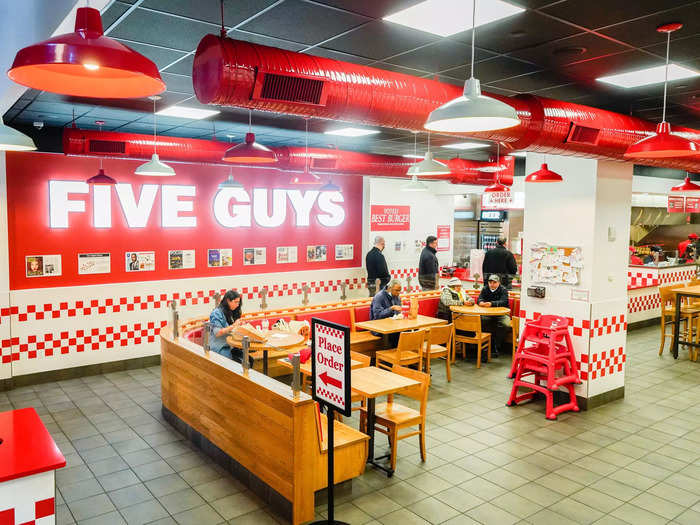
What started out as a family-owned burger joint has seen massive expansion over almost four decades. Five Guys opened its first location in Arlington, Virginia, in 1986, and now has more than 1,700 locations across the US, Canada, Europe, and the Middle East.
After opening its first UK location in London's Covent Garden area in 2013, the company now operates over 130 restaurants throughout the country.
The chain is known for being more expensive than other fast-food restaurants, and that remains constant across the pond.
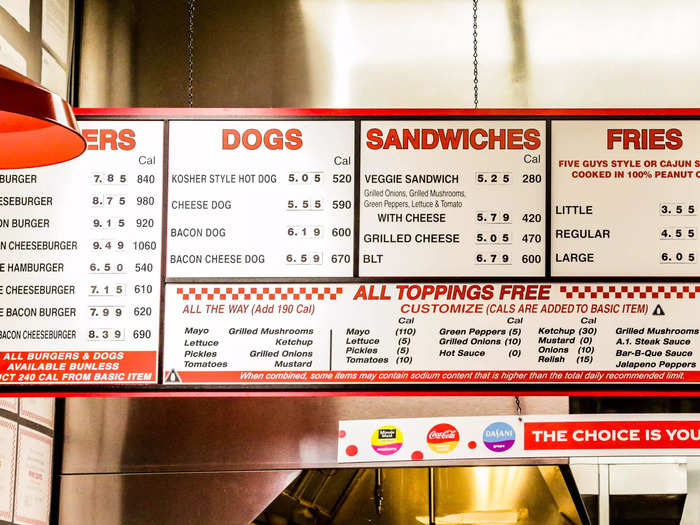
While fast-food restaurant menus often feature combination options and meal deals, Five Guys famously has an exclusively à la carte menu.
Though all toppings and sauces can be added to any sandwich or hot dog for free, the starting prices are higher than they are at other chains. (Prices vary by market, and you can check your local menu on the chain's website.)
There are some tips and tricks that can help diners save some money at the chain, but ultimately, Five Guys' promise of all-fresh ingredients comes at a higher price.
So we headed to a location in London and one in NYC to compare the prices and portion sizes at each.
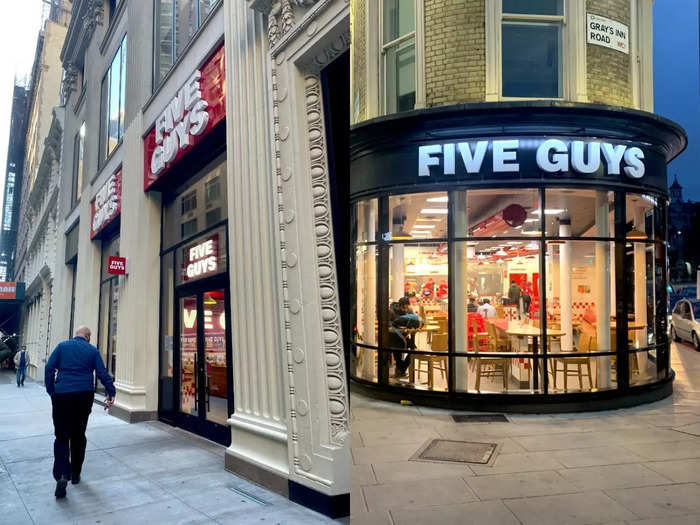
Rachel, Insider's New York-based food reporter, headed to her local Five Guys location in lower Manhattan.
The space was large and open for a New York restaurant. The open kitchen concept that the chain prides itself on was in full swing and Billy Joel's greatest hits blared through the speakers as she ordered and waited for her to-go meal.
Meanwhile, Insider's London-based Lifestyle fellow Maria Noyen made her way to her closest Five Guys in Kings Cross. It was late in the afternoon, so there were only a few diners eating in, but the kitchen was bustling with chefs preparing orders, likely for takeaways.
While waiting for her order, she thought the restaurant was playing Christmas music. It wouldn't have been too out of character given the UK basically goes from Halloween to the festive season without a Thanksgiving interlude, but on further assessment, it was just some soft indie music.
To keep things as equal as possible, we each ordered the same meal and compared item by item, starting with the cheeseburger.
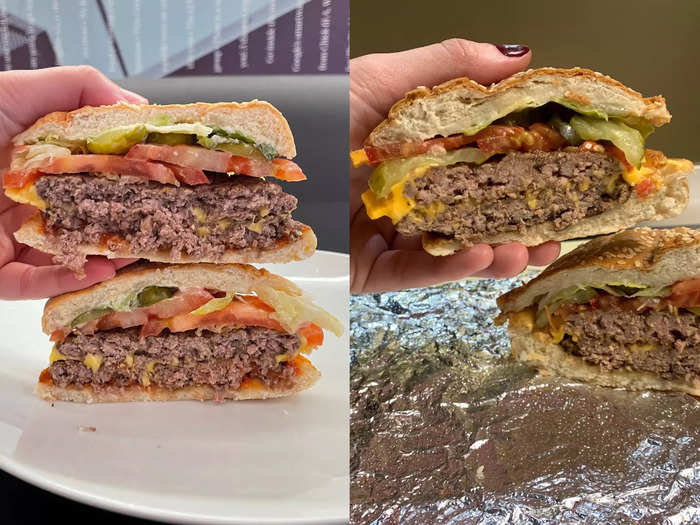
Both reporters got a cheeseburger, little-sized fries, and a milkshake.
They measured and compared for around an hour before diving in to taste the burger itself, which is why both were a bit cold. While our UK reporter thought the cheese looked almost like plastic by that time, she noted that it was a lot softer and less chewy than she expected.
Both sandwiches were dressed with two slices of cheese that came uniformly set between the two patties.
The ridged pickles, which were consistent for both the UK and the US orders, and the tomatoes held their shape. They seemed to be more meticulously laid out in Rachel's sandwich, though.
Both Maria and Rachel thought their respective patties were a perfect medium-rare, featuring tinges of pink in the middle. Though Five Guys representatives previously told Insider in an interview that all their meat is cooked to a well-done temperature. The meat was still moist despite the time passing.
Maria said the sesame-seed-covered bun did get a little soggy from holding in all the juices. Rachel found the same but hadn't noticed this happen in other burgers she's ordered from the chain.
After weighing and measuring each burger, we determined that diners in the UK are spending almost $3, or around £2, more for a cheeseburger than diners in the US.
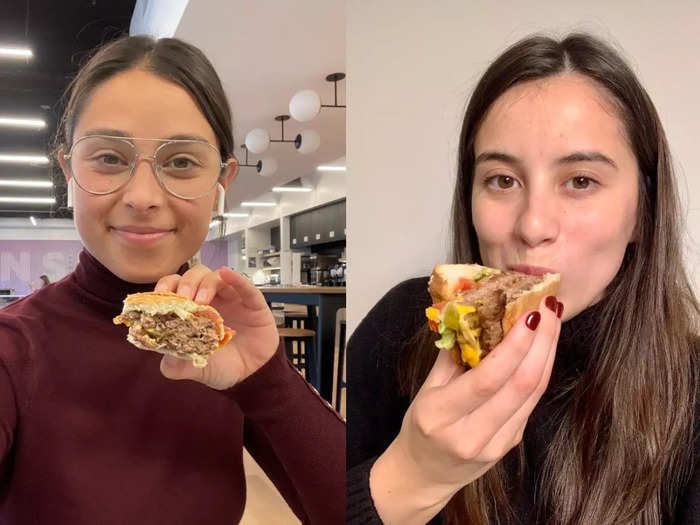
Maria's cheeseburger cost £8.95, or around $11.98. The burger weighed 290 grams, was around 3 1/2 inches in length, and was just under 1/2-inch thick.
The toppings were consistent across both UK and US orders with five pickles, two slices of tomato, and a few torn leaves of lettuce. Maria's pickles were roughly 1 1/4 inches in diameter, whereas the tomatoes, which both reporters noticed kept a good shape, were nearly 3 inches in diameter.
Rachel's cheeseburger weighed in at 320 grams, was 4 inches in diameter, and cost her $9.39, or around £7.02.
While the measurements of the pickle chips, which were slightly sweet but mostly salty and briny, were consistent with Maria's, Rachel's tomatoes were much larger at 2 1/2 inches in diameter.
They each ordered a little fry, which is the chain's smallest option for potatoes.
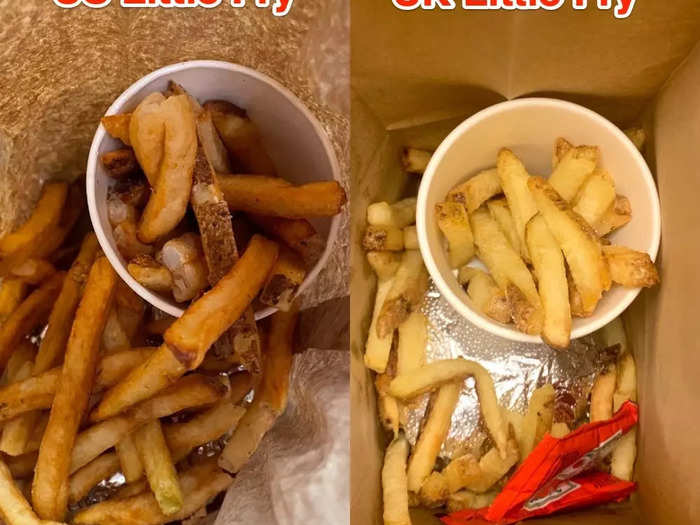
Though they ordered the smallest size fries, Five Guys is known for giving diners an extra scoop for every order. So it wasn't surprising that there was a pile of fries dancing loosely in the grease-soaked paper bag.
Right off the bat, both Rachel and Maria noticed a color difference between the UK and US fry orders. Maria's were a much lighter shade of yellow and had less of the crispy potato skin visible.
Maria's fry order, when measured without the cup they came in, weighed 180 grams, and the longest fry out of the batch was 4 1/2 inches — though fry length likely just depends on the season as the chain's potatoes are sourced from farms around the country.
The average fry was around 1/4-inch thick, Maria reported. Rachel noted that each fry in her order was 1/2-inch thick.
Given the wait time between picking up the order and eating it, neither reporter was surprised that they were cold. However, when Maria bit into hers, she did notice the mashed potato bits on the inside were slightly colder than the crisp outside. Rachel noticed the same.
Rachel also noted a deep flavor from the frying oil that Maria didn't seem to have. They thought it was indicative of the difference in coloring and what that meant for how long each batch of fries had been cooked. (Five Guys is known for cooking its boardwalk-style fries twice in order to get the perfect potato.)
Overall, our UK reporter found the fries were still salty, crispy, and greasy even without being fresh — so much so that she needed to wash them down with a sip of her shake.
While the price was about the same for this item, the coloring and flavor were a bit different.
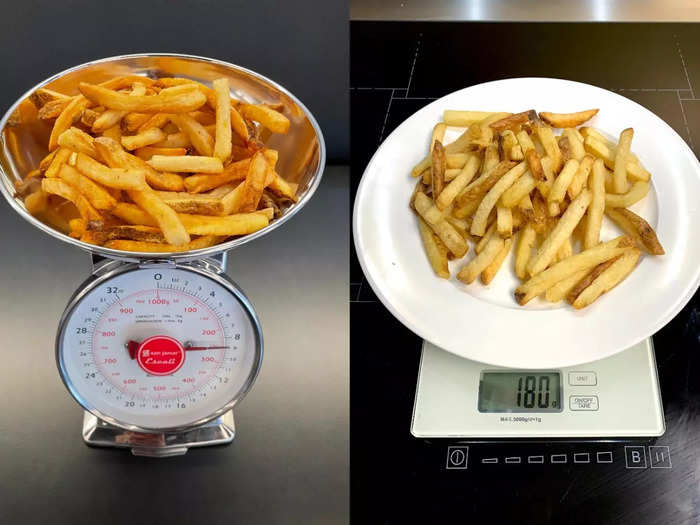
Maria's order of little fries cost £3.25, or around $4.37. Meanwhile, Rachel's fries were priced at $4.09, or around £3.05.
The price difference was relatively negligible here, but the main difference lied in the coloring and flavor. Ultimately, the fries in the US seemed to have more flavor than those in the UK.
We also compared the milkshakes on offer, which come in a variety of flavors depending on the market.

The availability of specialty shakes is a key difference our reporters found between the UK and US menus. There are three "dessert shakes" on offer in the UK: Strawberry Cheesecake, Millionaire Shortbread, and Banoffee Pie.
Maria decided to order the Banoffee Pie shake, an iteration of a quintessential English dessert consisting of layers of cream, caramel sauce, and sliced bananas atop a crumbly cookie-like base.
When she tried it, her first thought was that it tasted similar to a regular banana milkshake, but she wasn't overwhelmed with a fruity flavor. Maria also found the chunks of Lotus Biscoff, usually served alongside a cup of tea, absorbed a lot of liquid and lost the tell-tale crunch looked for when enjoying actual Banoffee pie.
Rachel went with a classic American favorite: cookies and cream. She ordered the Oreo shake, which also came in just one size, and thought the flavor was spot-on.
She tried it fresh and also after around an hour. Even after waiting, the center was still relatively thick and very enjoyable, though the outer layer was less viscous.
The Oreo cookie bits were still somewhat crunchy, which Rachel said provided a nice variation in texture, and she was able to taste the creme filling very clearly.
Though the UK menu offers more flavor variety for the shakes, US customers are getting a better deal when it comes to price.

Maria added whipped cream to her Banoffee Pie shake for no additional price. All in all, the cost came out to £5.20, or around $7. The cup it came in was just over 5 inches tall and the entire shake, with the cup but without the whipped cream, weighed roughly 408 grams.
She had spooned most of the whipped cream into a separate bowl and poured the sweet drink into a measuring jug — it came to around 450 milliliters, or nearly 2 cups.
Rachel's shake didn't have whipped cream on it, but it came in the same size cup. It weighed 380 grams and measured out to the same 2 cups, or 450 milliliters. The shake cost our US reporter $5.49, or around £4.10.
At roughly $1.50, or around £1.12, less, the US store we visited had the better deal for this item.
But a notable difference between the two markets is that the UK offers more flavor options than the US does.
No good fast-food meal is complete without sauce, so we ordered every option available in the UK and the US for our test.
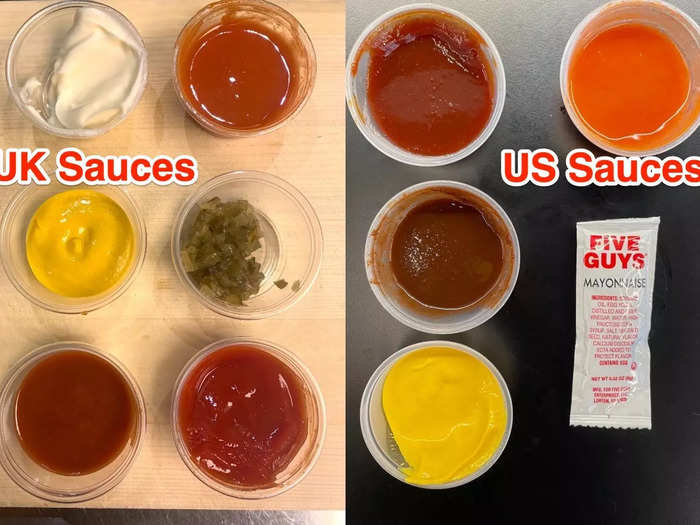
Before leaving the restaurant, Maria asked her server if she could have one of each sauce available. She ended up getting hot sauce, ketchup, mayonnaise, mustard, barbecue sauce, and relish.
When Rachel made the same request at her store, she received hot sauce, mustard, barbecue sauce, A1 steak sauce, and packets of mayonnaise — sides of ketchup were self-serve.
Maria reported some big differences in the servings of each sauce. Hot sauce and ketchup were given the biggest portions, as both weighed 39 grams, she said, whereas the relish came out to around 19 grams and barely filled half of the small serving cup.
Rachel's sauces came a bit more evenly distributed, most of which filled the containers at least halfway.
While it was left out of Maria's order, Five Guys in the UK does offer a steak sauce, but the brand they use is called HP sauce. Similarly, the two locations use different brands of barbecue sauce: McCormick in the UK and Cattlemen's in the US.
The most important thing to note here is that regardless of the differences, all sauces were free at both locations.
Overall, the UK and US menus were generally consistent. The biggest differences came down to price, the color of the fries, and the variety of shake flavors.
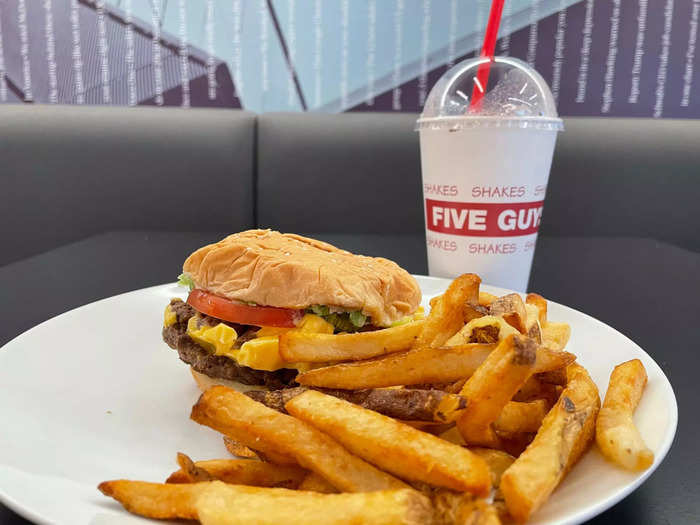
Other than price, the biggest discrepancies between the meal came down to the color of the fries, which could possibly be attributed to the type of potato used in the UK or simply the kind of potato used for Maria's individual order. The other possibility could be a difference in cook time, but that's unlikely in a chain that emphasizes uniformity. Both reporters noted that the restaurant uses the same peanut oil in their locations, so it was likely not a factor in the way the potato was fried.
The final obvious difference between the cross-Atlantic orders was the variety and flavors of milkshakes. The UK menu had all of the US mix-ins as well as coffee and Lotus Biscoff, a type of cookie, on offer. They also had specialty shakes, such as the Banoffee Pie, that appealed to staple British treats.
But when it comes down to it, it's all about the price. Maria ended up paying a total of £17.40, or around $23.30, for her meal. Meanwhile, Rachel spent $18.97, or around £14.18, on an identical order in the US, which left a price difference of $4.33, or around £3.24, between them. So ultimately, the New York customer is getting a better bang for their buck than the London customer.
READ MORE ARTICLES ON
Popular Right Now
Popular Keywords
Advertisement